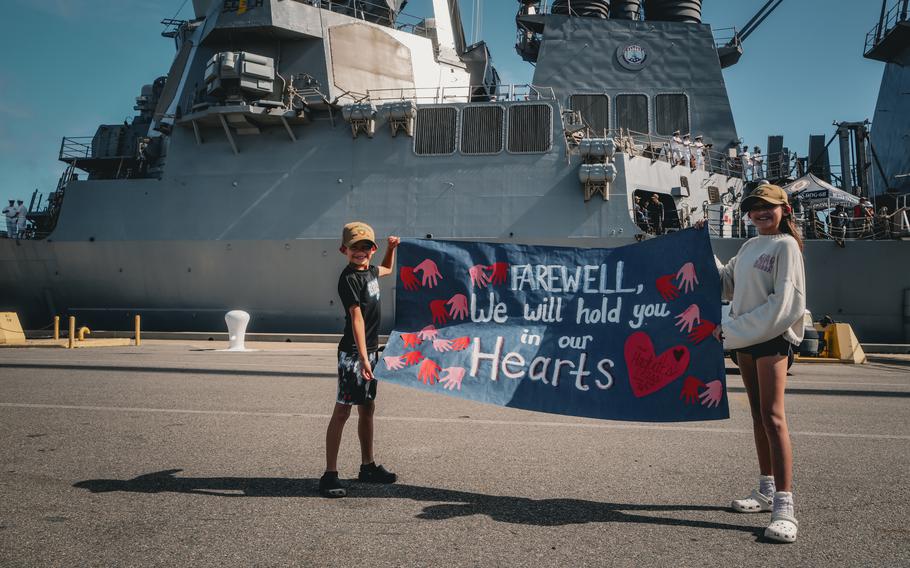
The Arleigh Burke-class, guided-missile destroyer USS The Sullivans departs Mayport, Fla. for a scheduled deployment to the U.S. 5th Fleet area of operations, which includes the Arabian Gulf, Gulf of Oman, Red Sea and parts of the Indian Ocean. (Alexa H. Trafton/U.S. Navy)
WASHINGTON — A group of B-52 bombers have arrived in the Middle East and the destroyer USS The Sullivans deployed two days ago after Defense Secretary Lloyd Austin ordered more U.S. armed forces to the region.
The bombers arrived in the region during the weekend, Air Force Maj. Gen. Pat Ryder, the top Pentagon spokesman, confirmed Monday. Additionally, The Sullivans departed Saturday from Naval Station Mayport, Fla., for an independent deployment to the U.S. 5th fleet area of operations, which includes the Arabian Gulf, Gulf of Oman, Red Sea and parts of the Indian Ocean, the Navy said.
The military assets are moving to the Middle East after Austin on Friday ordered several B-52s, a squadron of fighter jets, tanker aircraft and Navy destroyers to deploy to the region. The other ships and planes will arrive in the coming months as the aircraft carrier USS Abraham Lincoln ends its deployment there and transitions back to the United States.
“These appointments are in keeping with our commitment to the protection of U.S. citizens and forces in the Middle East, the defense of Israel and deescalation through deterrence and diplomacy,” Ryder said.
The bombers, which are part of Minot Air Force Base’s 5th Bomb Wing, N.D., have strategic, long-range capabilities. The Sullivans, an Arleigh Burke-class, guided-missile destroyer, is armed with vertical launch anti-submarine rockets, Tomahawk missiles and MK-46 torpedoes and is capable of shooting down ballistic missiles.
“The Sullivans’ crew is trained and ready to engage in a variety of activities, from escorting ships to participating in joint exercises with allied and partner navies in the Middle East,” said U.S. Fleet Forces, which oversees East Coast-based Navy warships.
The military moves come as Israel’s wars against Hamas militants in Gaza and Hezbollah militants in Lebanon rage, including a retaliatory strike on Iran a week ago that likely damaged a base that builds ballistic missiles and launches rockets as part of the country’s space program.
The U.S. is pressing for cease-fires while repeatedly saying it will defend Israel and continue to protect Americans and allies in the region, including from Yemen-based Houthi attacks against ships in the Red Sea.
Austin’s latest order shows the “U.S. capability to deploy worldwide on short notice to meet evolving national security threats,” Ryder said. Austin “continues to make clear that should Iran, its partners, or its proxies use this moment to target American personnel or interests in the region, the United States will take every measure necessary to defend our people.”
The Lincoln and two of its destroyers are now in the Gulf of Oman, and its third destroyer is with two other warships in the Red Sea. It deployed July 11 from its homeport of Naval Base San Diego for what was intended to be a Pacific tour, but the carrier’s strike group was directed to the Middle East in late August. The group is expected to leave the region in the coming months.
The USS Harry S. Truman aircraft carrier and its three warships will move to the Mediterranean Sea, but the group won’t get there before the Lincoln departs. The Truman strike group has been in the North Sea, participating in a NATO military exercise. The battle group deployed from Naval Station Norfolk, Va., and Naval Station Mayport in September.
There are also two destroyers and the USS Wasp amphibious ready group, which includes three ships, in the Mediterranean. The Wasp group, which includes the amphibious transport dock ship USS New York and dock landing ship USS Oak Hill along with elements of the 24th Marine Expeditionary Unit, deployed June 1 from Naval Station Norfolk and Joint Expeditionary Base Little Creek-Fort Story, Va.
The Sullivans returned in February from a two-month deployment to the Mediterranean. The ship defended against ballistic missiles amidst the Israel-Hamas conflict.
The Sullivans, alongside USS Delbert D. Black, additionally provided relief for the USS Thomas Hudner and USS McFaul, allowing both ships to return home after multiple deployment extensions. The Sullivans also escorted the USS Gerald R. Ford carrier strike group and USS Bataan amphibious readiness group during their deployments.
“This deployment is [The Sullivans’] fifth deployment in three years, reflects the Navy’s ongoing commitment to ensuring a strong U.S. presence in critical areas and further bolsters the U.S. deterrence posture in the region, providing increased options to the combatant commander,” U.S. Fleet Forces said.
The Associated Press contributed to this report.